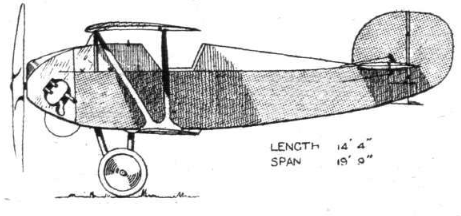Bristol Babe on:
[Wikipedia]
[Google]
[Amazon]
The Bristol Babe was a British-built light single-seat
 Finding a suitable small engine proved difficult. The original intention was to use the 60 hp (50 kW)
Finding a suitable small engine proved difficult. The original intention was to use the 60 hp (50 kW) 

biplane
A biplane is a fixed-wing aircraft with two main wings stacked one above the other. The first powered, controlled aeroplane to fly, the Wright Flyer, used a biplane wing arrangement, as did many aircraft in the early years of aviation. While ...
, intended for the private flyer and produced immediately after the First World War
World War I (28 July 1914 11 November 1918), often abbreviated as WWI, was one of the deadliest global conflicts in history. Belligerents included much of Europe, the Russian Empire, the United States, and the Ottoman Empire, with fightin ...
. Only two flew.
Development
The Bristol Babe was the creation ofFrank Barnwell
Captain Frank Sowter Barnwell OBE AFC FRAeS BSc (23 November 1880 – 2 August 1938) was a Scottish aeronautical engineer. With his elder brother Harold, he built the first successful powered aircraft made in Scotland and later went on to a c ...
, a flying enthusiast as well as Bristol's chief designer. It was aimed at the private owner flyer and was a small single-engined single-seat biplane with unswept staggered single-bay wings of unequal span. Full-span ailerons were fitted on the top wing only. The fuselage
The fuselage (; from the French ''fuselé'' "spindle-shaped") is an aircraft's main body section. It holds crew, passengers, or cargo. In single-engine aircraft, it will usually contain an engine as well, although in some amphibious aircraft t ...
was plywood
Plywood is a material manufactured from thin layers or "plies" of wood veneer that are glued together with adjacent layers having their wood grain rotated up to 90 degrees to one another. It is an engineered wood from the family of manufactured ...
-skinned, with fabric covering it for protection. The cockpit was below the upper wing trailing edge with rounded decking aft to the tail. The fin and rudder
A rudder is a primary control surface used to steer a ship, boat, submarine, hovercraft, aircraft, or other vehicle that moves through a fluid medium (generally aircraft, air or watercraft, water). On an aircraft the rudder is used primarily to ...
were generous and rounded, the undercarriage a conventional single-axle plus tailskid arrangement.
 Finding a suitable small engine proved difficult. The original intention was to use the 60 hp (50 kW)
Finding a suitable small engine proved difficult. The original intention was to use the 60 hp (50 kW) ABC Gadfly
ABC are the first three letters of the Latin script known as the alphabet.
ABC or abc may also refer to:
Arts, entertainment, and media Broadcasting
* American Broadcasting Company, a commercial U.S. TV broadcaster
** Disney–ABC Television ...
radial, but in April 1919 ABC
ABC are the first three letters of the Latin script known as the alphabet.
ABC or abc may also refer to:
Arts, entertainment, and media Broadcasting
* American Broadcasting Company, a commercial U.S. TV broadcaster
** Disney–ABC Television ...
pulled out of aero-engine manufacture. A possible alternative was the 40 hp (30 kW) flat-twin Siddeley Ounce currently being developed, so a third Babe was begun as a testbed. In the meantime, Barnwell resurrected a 1911 Viale 35 hp
The Viale 35 hp was a five-cylinder, air-cooled, radial engine for aircraft use designed and built in France by the Italian engine designer Spirito Mario Viale, that was first run around 1910. It developed 35 horsepower (26 kW). Three ...
five-cylinder radial engine of 45 hp (34 kW) that had been installed in an Avro Type F and which had been put into storage following a crash. This engine ran satisfactorily for up to half an hour, after which it tended to overheat. This was installed in the second Babe which made its first flight on 28 November 1919. The pilot, Cyril Uwins reported that it was an easy aircraft for an experienced pilot but rather unstable for a novice. Though it was useful for testing, the old Viale was not reliable enough for sale, so following discussions at the Paris Aero Show in November 1919, two seven-cylinder 60 hp (50 kW) Le Rhône Type 7B2 rotary engines were ordered for the first two Babes. The third Babe appeared at this show with an incomplete Ounce engine.
The second Babe built was referred to as the Babe I when it had the Viale engine and then as the Babe III with the Le Rhône engine. The Le Rhône-powered first machine was the other Babe III. The Ounce-powered third machine, designated Babe II, never flew, but the two Babe IIIs did and were registered over the winter of 1919-20.
The first Babe underwent a drastic modification in May 1920 when it received a thick cantilever monoplane wing. Safety concerns prevented its testing and by February 1921 both aircraft were off the Civil Register. The Viale engine is now in the Science Museum, London. In the retrospective allocation of Bristol type numbers made in 1923, the Babe I was labelled Type 30, the Babe IIs as Type 46 and the unflown Babe III the Type 46A.
Specifications (Babe III)

References
Citations
Bibliography
* * * {{Bristol aircraft Sesquiplanes Single-engined tractor aircraft 1910s British sport aircraftBabe
Babe or babes may refer to:
* Babe, a term of endearment
* A newborn baby
* An attractive (especially female) person
People Nickname
* Babe Adams (1882–1968), American Major League Baseball pitcher
* Babe Barna (1917–1972), American Maj ...
Aircraft first flown in 1919
Rotary-engined aircraft